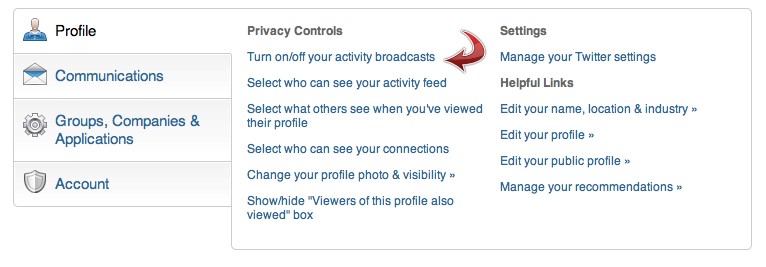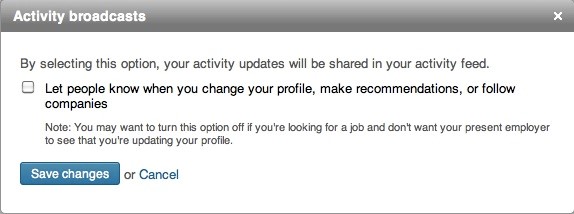LinkedIn is the top social net working site for passive candidates who want to be found. With some employers, simply having a LinkedIn profile might draw suspicion that you’re looking for a job, so you want to be careful how you use the site.
working site for passive candidates who want to be found. With some employers, simply having a LinkedIn profile might draw suspicion that you’re looking for a job, so you want to be careful how you use the site.
First, find out what your current company’s policy is about LinkedIn. If there isn’t one, consider approaching your boss about the strategic value of company employees having a presence on the social networking site — for business reasons — because, as LinkedIn itself points out, “Just because you use LinkedIn doesn’t mean you’re looking for a job. Many people use LinkedIn to keep in contact with others and help them succeed in their current position.”
Your company may even encourage development of your LinkedIn profile. Some reasons your company may support employees being involved on LinkedIn include:
- It makes the company profile more robust to have current employees affiliated with the company on LinkedIn.
- So that employees can connect with potential customers.
- Because employees can demonstrate thought leadership and expert positioning for the company through involvement in LinkedIn Groups related to the company’s work.
- To help the company connect with potential employees who may reach out to current employees through LinkedIn.
However, even if your company supports your involvement on LinkedIn for business purposes, you still want to limit your perception as an active jobseeker (vs. being seen as an active business professional). And make sure you update your LinkedIn profile gradually, if possible. Adding lots of information and connections all at once can look suspicious.
How NOT to Get Noticed on LinkedIn
Here are some specific actions you should take on LinkedIn to support your stealth job search, while still being visible for business connections and to facilitate unsolicited job opportunities:
Turn off your activity broadcasts. This is the first step to take, as it will ensure that your entire network isn’t notified every time you make a change to your profile. If you don’t turn off this setting, all of your Connections will receive notifications of every change you make to your LinkedIn profile. So turn off your activity broadcasts before making any changes!
On the main menu, click on the thumbnail of your profile photo (which appears at the very top right of your profile, on the main menu bar).

From the drop-down menu, click on the blue “Review” link next to “Privacy & Settings.”

Once on the “Privacy & Settings” page, click on the blue link for “Turn on/off your activity broadcasts” under the “Privacy Controls” section.

A pop-up page will appear. Make sure the box is unchecked where it says, “Let people know when you change your profile, make recommendations, or follow companies.”

Click the blue “Save changes” button.
You’ll be taken back to the Privacy & Settings page. Continue to use “Privacy Controls” to make some additional changes.
Select who can see your activity feed. Your choices are: Everyone, Your Network (these include “friends of friends”), Your Connections, and Only You. Choose “Only You.”
Click “Save changes.”
Select who can see your list of connections. The choices are: Your Connections or Only You. Who you know is actually valuable information for future employers who are considering hiring you or searching for you on LinkedIn, so leave this as “Your Connections.”
Select the type of messages you’re willing to receive. Do not click the “Career Opportunities,” “Job Inquiries,” or “New Ventures” boxes — these will show up on your Profile. However, you can check “Expertise Requests,” “Business Deals,” “Personal Reference Requests,” and “Requests to Reconnect” boxes.
And be sure to fill in the “Advice to People Who Are Contacting You” section on that page. In particular, include your personal phone numbers (home and/or cell) to facilitate employment-related contacts.
Manage your Recommendations. Cultivate these over time — suddenly adding several Recommendations at once may raise suspicion. So request Recommendations over a period of time (for example, one per month), so that they appear to be more organically cultivated.
Don’t reveal confidential information on your LinkedIn profile. You want to quantify accomplishments, but not disclose company secrets. Focus on how you’ve helped the company stand out and be successful, not how you stand out and are successful.
Don’t participate in LinkedIn Groups for jobseekers while you’re employed. Instead, participate in LinkedIn Groups where you might be found by recruiters or future employers. Contribute your expertise (and carefully considered comments) in job function-specific or industry Groups.
Build your network of contacts slowly. Do not send out multiple connection requests within a short period of time. If your number of connections jumps from 20 to 120 in just days, that’s suspicious to anyone who might be checking out your profile. (However, you definitely want to get your connection number above 100. But do it over a period of time, not all at once.)
Do not use LinkedIn’s profile blocking feature to minimize your LinkedIn visibility to your current boss or colleagues. This will only raise red flags if they know you have a LinkedIn profile but can’t access it. (They can simply ask a friend or colleague to log into their own LinkedIn account and pull up your LinkedIn profile.) If you had previously blocked supervisors or colleagues for this reason, LinkedIn now allows you to “unblock” these individuals. Instructions and your list of blocked individuals can be found at:
http://www.linkedin.com/settings/member-block-list
Don’t upgrade to the paid jobseeker membership level. The last thing you need in your confidential job search is a job hunting icon on your LinkedIn profile.
If you’re conducting a confidential job search and are worried your boss will interpret your LinkedIn profile as a job-hunting tool, contact me today. I can help with strategies that will get you off your old boss’s radar and on your new boss’s contact list.
Related
The Confidential Job Search: How to look for a job when you have a job
photo credit: Swapnil Bhavsar, license








